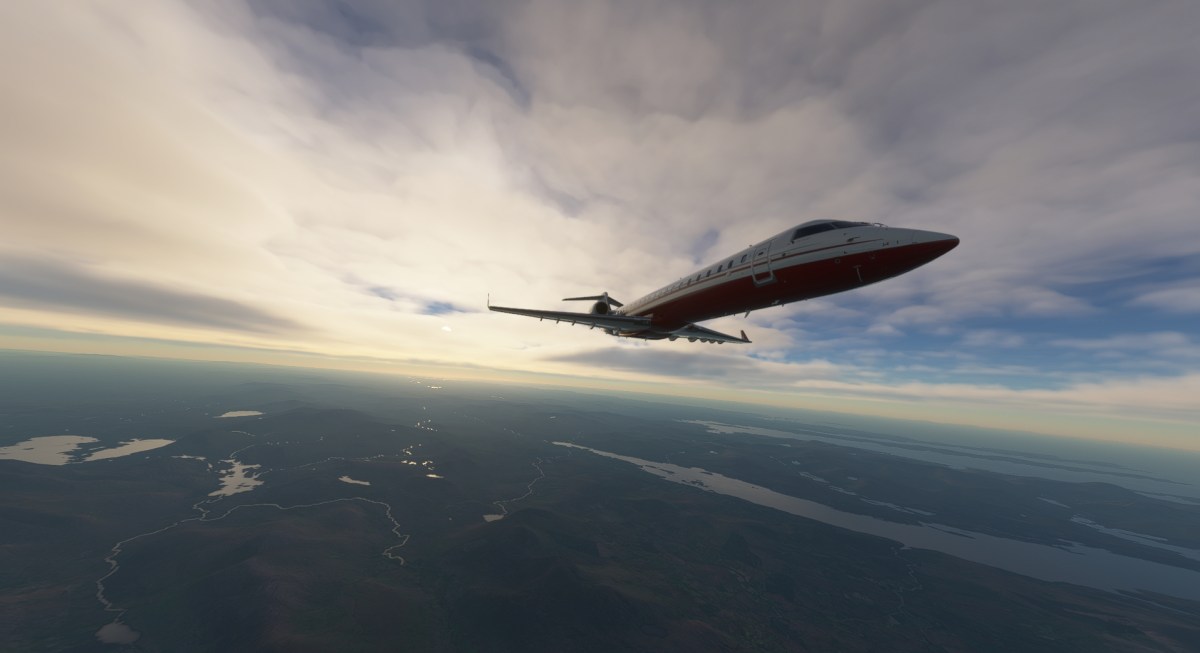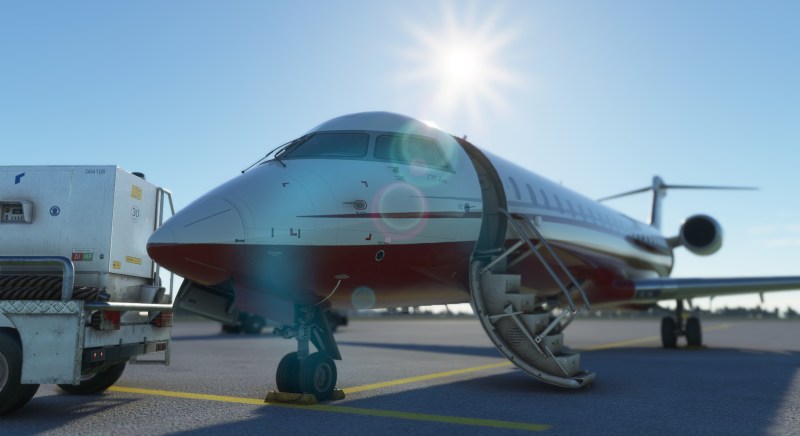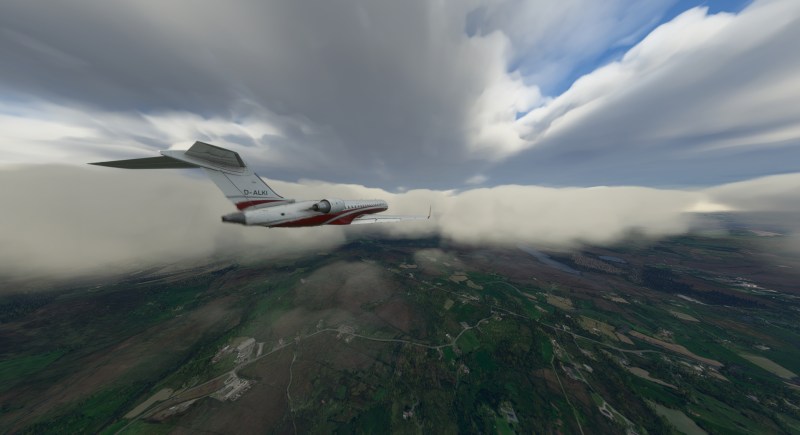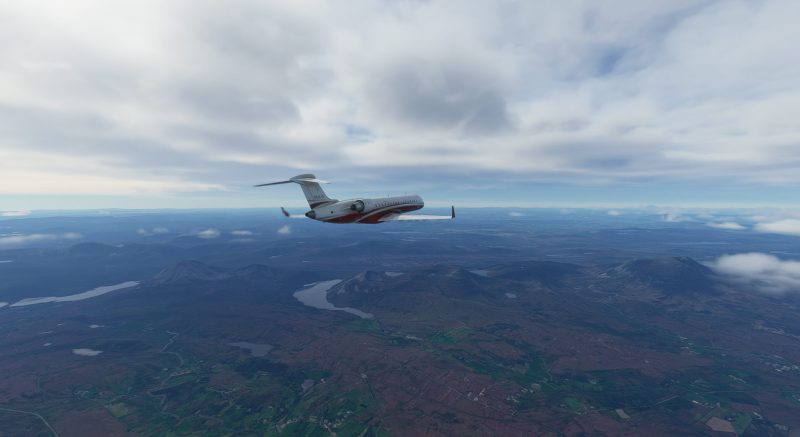Microsoft Flight Simulator itself was inundated with hype leading up to its release last summer. While the excitement of the ‘hot new toy’ has waned a bit, the simulator’s popularity has certainly not diminished much, if at all. That’s because the post-release is definitely what a lot of flight sim fans look forward to. The more time that passes, the larger the content pool grows. As of now, there are dozens of quality payware and freeware projects that have been released, and many more that are in development. But, one key group has been left out of the mix until now: core simmers. These are the folks who don’t just see flight simulation as a form of entertainment; they see it as a tool for training, studying, and learning about aviation. Thus, Aerosoft has stepped in to provide the first Microsoft Flight Simulator product in line with this very mindset: a ‘study-level’ airliner — the Mistubishi CRJ 550/700.
First produced in the late ’90s originally by Canadian manufacturer Bombardier, the CRJ 550/700 family is one of the most recognizable aircraft types in the world. It serves dozens of countries with under regional carriers. These short-haul rockets are designed to bus passengers to-and-fro on relatively short routes. Yet, they also do serve international routes in some instances. For example, I live in the Bahamas and the CRJs that come here are regularly flown by American Airlines and Delta from Florida. These journeys are still quite short (usually 30-45 minutes or less), which is typical for an aircraft of this type. Even though it’s not used for longer trips, the CRJ’s performance and avionics system is still quite the package, and Aerosoft has done a wonderful job capturing the essence of this beautiful airplane in virtual form.
Still, all this doesn’t change the fact that the add-on costs a hefty $50 USD. That’s nearly the price of Microsoft Flight Simulator itself! And if you’re using Xbox Game Pass, you definitely might look at that price tag and just laugh. But here’s the thing, it is worth the money — if you’re willing to also invest your time.
A freshman’s perspective
Before we get too deep into this, I want you to view this piece from the right perspective. For starters, despite me being the self-proclaimed “Sim Guy” of PC Invasion, I am actually not the target audience for such a product.
That said, this is not going to be a super in-depth, meticulous analysis of all the different systems and sub-systems that Aerosoft’s CRJ has and/or doesn’t have. On the contrary, this is actually going to be a piece from the perspective of someone who is new to these sorts of products and is looking around to see what all the fuss is about as people have literally been frothing at the mouth over this jet for months. Just check the Microsoft Flight Simulator subreddit and see for yourself. Even Asobo hyped up the release of the plane, straight up to the point of posting a trailer for it on the official Microsoft Flight Simulator YouTube channel. There are several other payware aircraft, and none of them have received this amount of attention. So, what gives?
As established, the Aerosoft CRJ is considered to be a product dedicated to the crowd of hardcore simmers who have been itching to treat Microsoft Flight Simulator as a full-on at-home virtual flight training facility. These aren’t the folks who just spend hours gawking at all the pretty scenery and./or doing loop-dee-loops in a 747. No, these guys are performing full IFR flights, sometimes even going as far as to communicate with virtual ATC via services like Vatsim using proper terminology and pilot jargon. This is the type of crowd the CRJ was made for. Alas, I’m nowhere near that level.
While I do treat my flight sim sessions more seriously than a novice would, I’m still more casual than these super serious virtual pilots. Thus, the intricacies of the CRJ’s craftmanship is, while not lost on me, not fully utilized at all by someone like me. And yet, I’ve had a blast flying this thing! Really, that right there is what makes the CRJ a good product in my eyes — it’s extremely complex and realistic, but still accessible. But again, you’ll still need to invest time into learning some of the ins-and-outs of this airplane. The main reason being: it’s just “built different.”
New set of rules
Incorporation of modern slang now off the checklist, that statement actually does apply here. The Aerosoft CRJ might be an add-on for Microsoft Flight Simulator, but it plays by different rules compared to the default aircraft and even some other add-ons. For instance, if you start a flight on any runway, a typical aircraft will be powered on and ready to go. But, not the CRJ. No matter what, the jet will always start ‘Cold & Dark,’ with all of its electrical systems off and the engines shut down. The interactive checklist that’s available for all of the default aircraft is also not present here. Sounding a little complicated? Well, yes and no.
On one hand, Aerosoft has outfitted the CRJ with an EFB (Electronic Flight Bag), which is a large tablet that’s mounted to the captain’s side of the cockpit. It’s this which really handles the functions and features of the CRJ.
There is the (non-interactive) checklist, performance charts (fuel and weight calculations, etc.), aircraft features (like opening and closing doors, etc.), maintenance operations, and operations for toggling different features. But, what’s arguably the most important function, at least for beginners, is the ability to switch to different aircraft states. With a tap, the CRJ can be prepared for engine start and taxi out. However, you’ll still need to learn how to properly turn on the engines yourself (and shut them down), as not even pressing the classic “Ctrl + E” command will turn everything on for you with this jet.
Another complex caveat is that the CRJ doesn’t actually communicate with some of the systems built into Microsoft Flight Simulator. This includes the GPS data, and also weather radar. Thus, setting up an IFR flight plan is handled using the fully functional FMC (Flight Management Computer).
Without programing the flight plan into it, the autopilot can’t follow the route automatically, leaving you to guide the aircraft’s direction using the HDG function. Learning the ins-and-outs of the FMC takes some time and studying; I opted to wing it (pun intended). You can get away with using the sim’s built-in VFR map and simply relying on the aforementioned HDG function. This works, but it’s not as convenient as the other airliners where you can “set it and forget it,” essentially.
The venerable Zibo 737 add-on for X-Plane 11 functions in a very similar fashion in terms of complexity. However, there are ways to use websites to create a flight plan file automatically and simply import the file into the FMC. Unfortunately, no such solution exists yet for Aerosoft’s CRJ for Microsoft Flight Simulator—or so I thought. It turns out that it is possible to do such a thing, and some kind souls have created simple tutorials on exactly how. That said, if you want to learn the fly the CRJ properly, you’re going to have to do some real work.
But let’s be real. While it’s great that Aerosoft included eight manuals to pour over, the average newcomer is not going to be into that. And truthfully, you can’t knock Aerosoft for not appealing to this type of customer completely. That’s really not their core business when it comes to add-ons like this. However, even I as a novice have been able to get by on a few YouTube videos and a little experience.
Dream bird
When you do get everything working and up in the air, the CRJ is a mighty beast. She’s smaller than any of the sim’s other airliners, but that size helps with its insanely fast speed and climbing ability. So far I’ve taken the CRJ around both the UK and Ireland, and it’s made easy work of every single route.
When I say this thing is a pencil rocket, she really rolls. It’s like flying the CJ4 or Longitude, just a tad bigger. The included HUD à la the Boeing 787 also makes it feel all the more fancy and engaging. I thought the A320 was a great all-rounder, but the CRJ really has taken the cake. While an aircraft of this type mostly serves routes far shorter than what an A320 usually operates, you could take it for longer jaunts. For the sake of realism though, about an hour or two is the sweet spot, and she fills such a role quite beautifully.
I’ve sung the praises of the Aerosoft CRJ throughout this piece; I even began this article already saying — yes, it is worth its asking price by all means. These add-ons take a lot to make, so their costs reflect the effort put into it (and they’re also niche products). Regardless, the price still will only be truly worth your while if you’re willing to put up with the jet’s complexities. That $50 should, under the best of circumstances, squeeze dozens upon dozens of hours (if not hundreds) of flight time (and/or learning time) out of you. Additionally, it’s also worth it if you’re willing to put up with its performance demands.
CRJ power play
Not only is the CRJ taxing on the player, but also the machine. This is really the only gripe I have with the product. It takes up a lot of extra resources on top of the already insatiable sim itself. While I normally average 40-50fps and see 30fps on occasion, the CRJ sits at exactly 20fps or sometimes lower in particularly demanding situations.
Its complexity pushes the sim harder, thus requiring more horsepower. We reached out to Aerosoft for comment, and one developer revealed just how much is going on behind the CRJ’s beautiful exterior. It features “far more code, more animations, more textures, more polygons, and more sounds.” All of this demands increased power, and it’s “something that will never change” according to Aerosoft. The team will optimize the plane further, but Aerosoft warns that this “will probably not result in a lot on its own.”
Additionally, the dev warned that there will be aircraft in the future that demand even more due to their increased amounts of code. For now, it seems the CRJ is most taxing on the CPU. The GPU is being used for the “animations, textures, and models,” and the amount of memory on the graphics card is also important. As for system RAM, Aerosoft recommends 32 GB. I have a mobile RTX 2060 (6 GB), Core i7-9750H, and 16 GB of RAM. It’s enough to get by, but it seems like my RAM is a bottleneck in this situation.
This being said, the current version of Microsoft Flight Simulator (v.1.14.5.0) has become notorious for poor performance. It’s possible this will all improve in the near future. Even so, the CRJ is still bound to push systems a little harder simply due to all that’s running under the hood.
All things considered, Aerosoft has kept its word and the wait certainly feels worth it all. While the Aerosoft CRJ is certainly not for everyone, this wild stallion is absolutely quite the ride if you’re willing to learn the ropes.
The precipitous asking price might cause some to shy away. However, if you can afford it (or perhaps find it on sale eventually), the Aerosoft CRJ is certainly worth checking out to experience what Microsoft Flight Simulator can truly do as a genuine flight simulator.















Published: Mar 23, 2021 12:00 pm